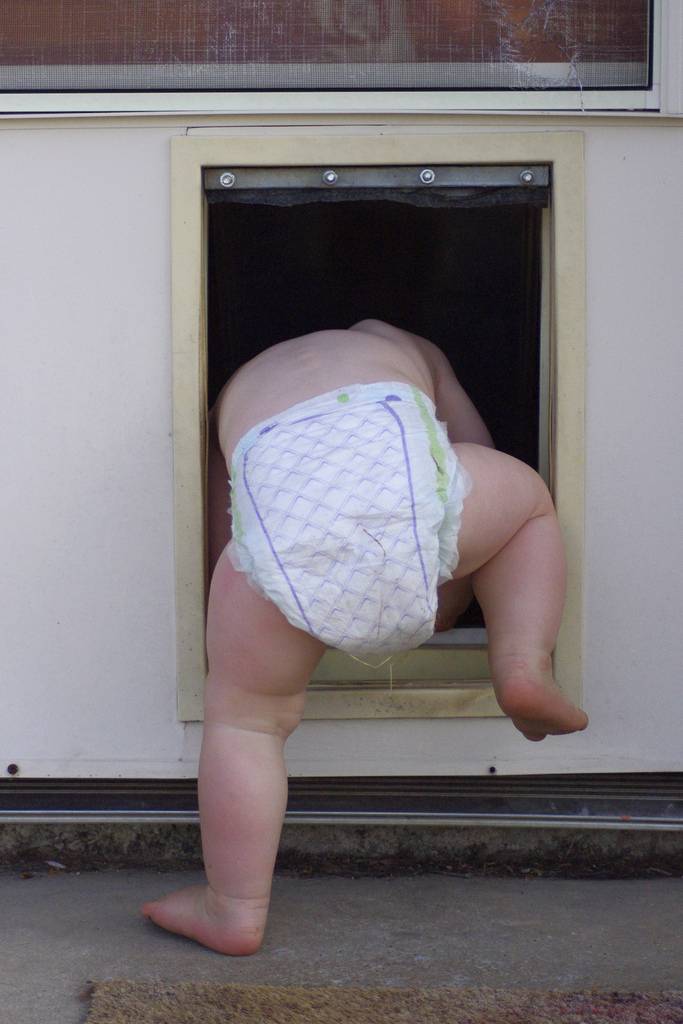Dive into the world of swimming with your child and make unforgettable memories this summer. Whether your little one is a baby, toddler, or older child, teaching them to swim is an essential skill that combines fun, fitness, and water safety!
Join us as we at Omega Pediatrics explore age-specific techniques and expert tips to guide you on how to teach your child to swim! From gentle water acclimation for babies to advanced stroke refinement for older children, let’s make swimming your favorite bonding activity this summer!
For Babies 2 Years Old and Below
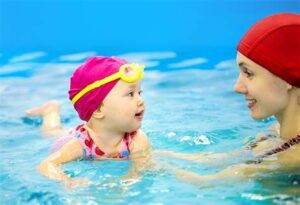
Teaching babies to swim is a gentle and gradual process. The primary focus at this age is to create a positive association with water and develop their comfort and confidence.
Ensure that the water is at a comfortable temperature and that the surroundings are safe before the swim session. Always be near the baby, providing physical support and reassurance throughout. Here are the steps to teaching a baby to swim:
1. Start with gentle water exposure.
Begin by holding your baby securely in your arms and gradually immersing them in the water, ensuring their face is above the surface. Use soothing words and maintain eye contact to establish trust.
2. Encourage kicking.
Support your baby in a horizontal position while their belly is facing down, allowing them to kick their legs into the water. This motion helps build leg strength and introduces the concept of movement in the water.
3. Practice floating.
While holding your baby under their arms, let their back and head rest against your chest, encouraging them to float on their back. Support their head and neck throughout the exercise.
4. Have some gentle splashing fun.
Incorporate gentle splashing and pouring water over your baby’s body to enhance their sensory experience and make them comfortable with water on their face.
5. Gradually submerge your baby.
As your baby grows more comfortable, gradually submerge them underwater for brief moments, starting with their feet and eventually progressing to fully immersing their body.
6. Maintain constant supervision.
Maintain vigilant supervision and ensure your baby’s safety during all water activities. Singing songs or nursery rhymes during water activities creates a fun and positive environment!
For Toddlers 2 to 3 Years Old
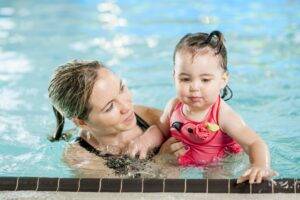
For toddlers in the age range of 2 to 3 years old, the approach to teaching swimming should focus on their increasing independence and motor skills. At this age, toddlers have limited attention spans and may become easily fatigued.
Keep the swimming sessions short yet engaging and enjoyable for your child. Most importantly, always prioritize their safety and closely monitor them while they are in the water.1. Gain water familiarity.
Start by gradually introducing your toddler to the water. Begin with shallow water and let them play and splash around, encouraging confidence and familiarity. Make the water activities fun and engaging to capture their interest and create a positive association with swimming.
2. Gently submerge your toddler.
Teach your toddler gentle submersion. Help them learn to hold their breath and blow bubbles by briefly submerging their face in the water. You can make it a game by using toys or counting, turning it into a fun and interactive experience.
3. Float with assistance.
Support your toddler under their shoulders and head while assisting in floating on their back. This position helps them develop body awareness and trust in the water. Gradually reduce your support as they become more comfortable and confident.
4. Work on the arm and kicking movements.
Encourage your child to kick their legs and move their arms in a coordinated manner. You can use colorful toys or flotation devices to make it more enjoyable and help them understand the motions.
5. Try edge-holding.
Promote the use of wall or edge holding. Encourage your toddler to hold onto the pool wall or edge, promoting a sense of balance and building arm and leg strength. This skill is essential for safety and developing confidence in the water.
6. Reduce assistance.
Gradual independence is key as your toddler becomes more comfortable and proficient in the water. Reduce your assistance gradually, allowing them to explore swimming independently under your close supervision.
Encourage them to practice the skills they have learned, and provide positive reinforcement for their efforts.
At this age, your child might be very active. Introduce basic water safety rules before they get into the pool. Begin with the basics, such as not running near the pool, always having adult supervision, and asking permission before entering the water.
For Toddlers 4 to 5 Years Old
Toddlers in the age range of 4 to 5 years old are ready for advanced swimming techniques and can start building on the skills they have already acquired.
Water safety skills are crucial at this age. Teach your child water safety skills, including how to enter and exit the water, recognize shallow and deep areas, and understand basic rescue techniques. Reinforce water safety rules and be aware of their surroundings.
1. Build your toddler’s confidence.
Reinforce your child’s confidence in the water through positive reinforcement and praise. Make swimming a fun and enjoyable activity for them, creating a supportive and encouraging environment.
2. Teach full immersion and breath control.
Teach your child to fully submerge their face in the water and practice holding their breath. Encourage blowing bubbles underwater, gradually increasing the duration of submersion. This helps them become comfortable with water on their faces and improves breath control.
3. Perfect floating and gliding.
Teach your child to float on their back and front with minimal assistance. Practice gliding through the water by pushing off from the wall or a pool ledge. These skills promote body control and buoyancy in the water.
4. Teach basic swimming strokes.
Start with simple strokes such as the doggy paddle or the front crawl. Break down the movements into manageable steps, and practice each component separately before combining them. Emphasize proper arm and leg coordination, breathing techniques, and body positioning.
5. Let your kid learn freestyle and backstroke.
After mastery of the basic strokes, introduce the freestyle (front crawl) and backstroke. These are fundamental swimming strokes that provide efficiency and speed in the water.
Emphasize proper technique, including arm movements, leg kicks, body rotation, and breathing. As your child practices these strokes, they will improve their overall swimming ability and gain confidence.
6. Engage in long-distance swims.
To increase endurance, gradually increase the distance your child swims. Set achievable goals and track their progress, encouraging them to challenge themselves while maintaining a sense of accomplishment.
Introduce interval training, alternating between faster and slower swimming speeds, to build both endurance and speed.
For Older Children 6 Years Old Up
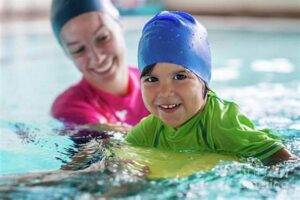
Children who are 6 years old and older have better coordination and comprehension skills, allowing for more advanced swimming techniques.
Before focusing on specific swimming skills, assess your child’s comfort level in the water. Evaluate their ability to float, submerge, and move through the water. This assessment will provide a baseline to guide their swimming instruction.
1. Refine your child’s strokes.
Focus on refining the freestyle, backstroke, breaststroke, and butterfly strokes. Break down each stroke into its components, emphasizing proper arm movements, leg kicks, body rotation, and breathing techniques.
Provide demonstrations and offer constructive feedback to help your child improve their technique.
2. Teach proper diving.
Teach your child proper diving techniques. Start from a standing position and progress to diving off the side of the pool. Emphasize the importance of entering the water safely and diving to appropriate depths. Practice this skill under close supervision to ensure their safety and comfort.
3. Encourage flip-turns.
Introduce flip-turns for pool swimming. Teach how to execute a smooth and efficient turn at the end of each lap. Emphasize proper body position, arm movements, and timing. Practice this skill while ensuring their safety and comfort.
4. Teach them how to tread water.
Treading water is an important skill to develop endurance and the ability to stay afloat. Teach your child different techniques, such as scissor kicks or eggbeater kicks. Gradually increase the duration of treading water to improve their stamina and endurance.
5. Engage in water rescue skills.
Teach your child essential water rescue skills, including reaching assists, throwing assists, and understanding how to identify and respond to water emergencies. Reinforce the importance of water safety rules and the responsibility to help others in need.
Consider enrolling your child in age-appropriate lifesaving and CPR courses. These courses equip your kid with valuable skills that can help save lives in water-related emergencies.
6. Increase the duration of swimming sessions.
To further build stamina and endurance, gradually increase the distance and duration of swimming sessions. Set goals and encourage them to participate in swimming competitions or join a swimming team, enhancing their skills and providing a sense of achievement.
The guidance of a certified swim instructor or lifeguard is beneficial when teaching children to swim, especially for advanced techniques and water safety skills. They can provide expert guidance, ensure proper technique, and prioritize safety.
Make Swimming a Bonding Time this Summer
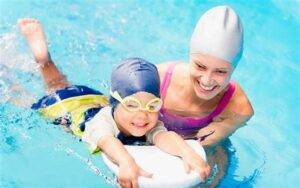
Teaching children to swim at different ages requires patience, encouragement, and a focus on creating a positive and safe environment. Adapt the instruction based on your child’s progress and individual needs.
Celebrate their achievements and provide support as they continue to develop their swimming skills and water safety awareness.
We at Omega Pediatrics encourage teaching your child how to swim at an early age. Swimming is a good cardiovascular exercise that helps your child’s stamina while fostering parent-child bonding. Start teaching your child how to swim today!

